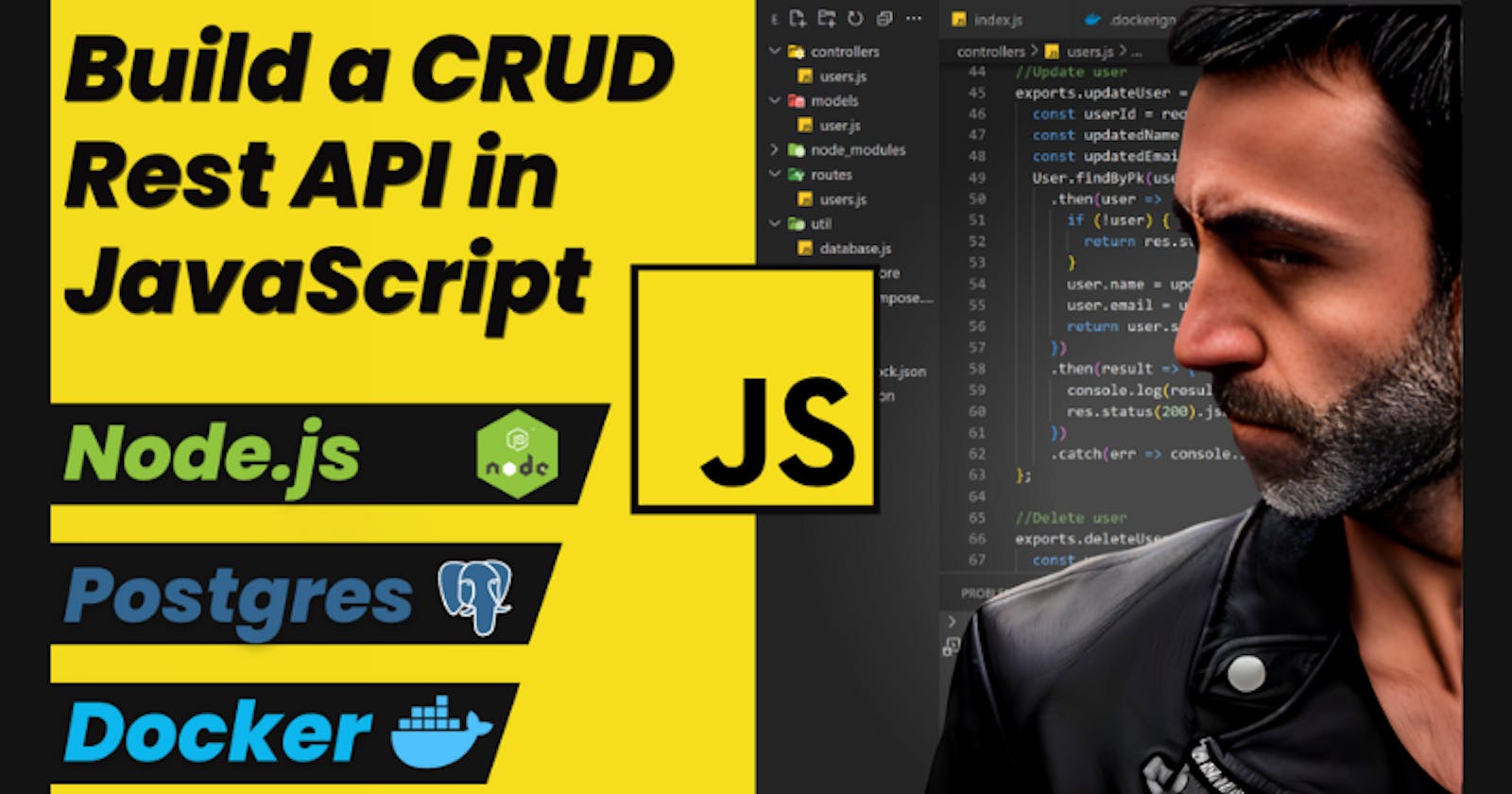JavaScript CRUD Rest API using Nodejs, Express, Sequelize, Postgres, Docker and Docker Compose
Here is a step-by-step procedure from scratch that will guide through the process of creating the APIS and dockerize the project
Let's create a CRUD rest API in JavaScript, using:
Node.js
Express
Sequelize
Postgres
Docker
Docker Compose
If you prefer a video version:
Intro
Here is a schema of the architecture of the application we are going to create:

We will create 5 endpoints for basic CRUD operations:
Create
Read all
Read one
Update
Delete
We will create a Node.js application using:
Express as a framework
Sequelize as an ORM
We will Dockerize the Node.js application
We will have a Postgres istance, we will test it with Tableplus
We will create a docker compose file to run both the services
We will test the APIs with Postman
Step-by-step guide
Here is a step-by step guide.
create a new folder
mkdir node-crud-api
step into it
cd node-crud-api
initialize a new npm project
npm init -y
install the dependencies
npm i express pg sequelize
express is the Node.js framework
pg is a driver for a connection with a Postgres db
sequelize is the ORM so we avoid typing SQL queries
create 4 folders
mkdir controllers routes util models
Open the folder with your favorite IDE. If you have Visual Studio Code, you can type this from the terminal:
code .
You should now have a folder similar to this one:

Now let's start coding.
Database connection
Create a file called "database.js" inside the "util" folder.
This file will contain the internal configuration to allow the connection between the Node.js application and the running Postgres instance.
Populate the util/database.js file
const Sequelize = require('sequelize');
const sequelize = new Sequelize(
process.env.PG_DB,
process.env.PG_USER,
process.env.PG_PASSWORD,
{
host: process.env.PG_HOST,
dialect: 'postgres',
}
);
module.exports = sequelize;
User model
Create a file called "user.js" inside the "models" folder.
This file will contain the model, in this case a user with an auto-incremented id, a name and an email.
Populate the models/user.js file:
const Sequelize = require('sequelize');
const db = require('../util/database');
const User = db.define('user', {
id: {
type: Sequelize.INTEGER,
autoIncrement: true,
allowNull: false,
primaryKey: true
},
name: Sequelize.STRING,
email: Sequelize.STRING
});
module.exports = User;
Controllers
This is the file that contains all the functions to execute in order to interact with the database and have the 4 basic functionalities:
Create a file called "users.js" inside the "controllers" folder
Populate the controllers/users.js file
const User = require('../models/user');
// CRUD Controllers
//get all users
exports.getUsers = (req, res, next) => {
User.findAll()
.then(users => {
res.status(200).json({ users: users });
})
.catch(err => console.log(err));
}
//get user by id
exports.getUser = (req, res, next) => {
const userId = req.params.userId;
User.findByPk(userId)
.then(user => {
if (!user) {
return res.status(404).json({ message: 'User not found!' });
}
res.status(200).json({ user: user });
})
.catch(err => console.log(err));
}
//create user
exports.createUser = (req, res, next) => {
const name = req.body.name;
const email = req.body.email;
User.create({
name: name,
email: email
})
.then(result => {
console.log('Created User');
res.status(201).json({
message: 'User created successfully!',
user: result
});
})
.catch(err => {
console.log(err);
});
}
//update user
exports.updateUser = (req, res, next) => {
const userId = req.params.userId;
const updatedName = req.body.name;
const updatedEmail = req.body.email;
User.findByPk(userId)
.then(user => {
if (!user) {
return res.status(404).json({ message: 'User not found!' });
}
user.name = updatedName;
user.email = updatedEmail;
return user.save();
})
.then(result => {
res.status(200).json({message: 'User updated!', user: result});
})
.catch(err => console.log(err));
}
//delete user
exports.deleteUser = (req, res, next) => {
const userId = req.params.userId;
User.findByPk(userId)
.then(user => {
if (!user) {
return res.status(404).json({ message: 'User not found!' });
}
return User.destroy({
where: {
id: userId
}
});
})
.then(result => {
res.status(200).json({ message: 'User deleted!' });
})
.catch(err => console.log(err));
}
Routes
Create a file called "users.js" inside the "routes" folder.
Populate the routes/users.js file
const controller = require('../controllers/users');
const router = require('express').Router();
// CRUD Routes /users
router.get('/', controller.getUsers); // /users
router.get('/:userId', controller.getUser); // /users/:userId
router.post('/', controller.createUser); // /users
router.put('/:userId', controller.updateUser); // /users/:userId
router.delete('/:userId', controller.deleteUser); // /users/:userId
module.exports = router;
Index file
To run our application we need to create on more file at the root level. this is the file that will be executed by the docker container.
in the root folder, create a file called index.js
Populate the "index.js file":
const express = require('express');
const bodyparser = require('body-parser');
const sequelize = require('./util/database');
const User = require('./models/user');
const app = express();
app.use(bodyparser.json());
app.use(bodyparser.urlencoded({ extended: false }));
app.use((req, res, next) => {
res.setHeader('Access-Control-Allow-Origin', '*');
res.setHeader('Access-Control-Allow-Methods', 'GET, POST, PUT, DELETE');
next();
});
//test route
app.get('/', (req, res, next) => {
res.send('Hello World');
});
//CRUD routes
app.use('/users', require('./routes/users'));
//error handling
app.use((error, req, res, next) => {
console.log(error);
const status = error.statusCode || 500;
const message = error.message;
res.status(status).json({ message: message });
});
//sync database
sequelize
.sync()
.then(result => {
console.log("Database connected");
app.listen(3000);
})
.catch(err => console.log(err));
Docker Part
Let's create 3 more files at the root level:
.dockerignore (it starts with a dot)
Dockerfile (capital D)
docker-compose.yml
The structure should look like this:

the .dockerignore will contain a single line:
node_modules

The Dockerfile
To create a Docker image we need a simple yet powerfule file. That's called "Dockerfile" (capital D). We might use a different name but let's keep things simple for now.
FROM node:14
# Create app directory
WORKDIR /app
COPY package*.json ./
RUN npm install
# Bundle app source
COPY . .
EXPOSE 3000
CMD [ "node", "index.js" ]
Docker compose file
To run multiple services an easy way is to create a file called "docker-compose.yml"
The docker-compose.yml file:
version: "3.9"
services:
node_app:
container_name: node_app
build: .
image: francescoxx/node_live_app
ports:
- "3000:3000"
environment:
- PG_DB=node_live_db
- PG_USER=francesco
- PG_PASSWORD=12345
- PG_HOST=node_db
depends_on:
- node_db
node_db:
container_name: node_db
image: postgres:12
ports:
- "5432:5432"
environment:
- POSTGRES_DB=node_live_db
- POSTGRES_USER=francesco
- POSTGRES_PASSWORD=12345
volumes:
- node_db_data:/var/lib/postgresql/data
volumes:
node_db_data: {}
Build the Docker image and run the docker containers
Run Postgres in a container
First, let's run the postgres container:
docker compose up -d node_db
To check the logs, we can type:
docker compose logs
you should get an output similar to this one:
![..... 2023-02-12 13:07:41.342 UTC [1] LOG: database system is ready to accept connections](https://dev-to-uploads.s3.amazonaws.com/uploads/articles/icy9s09od5sdja90drft.png)
if we see "database system is ready to accept connections" we are good to go!
Let's test it using TablePlus.
Click on the + to create a new connection

copy the values from the docker-compose.yml file. (password is 12345 if you left the values as they are)

Build and run the Docker service
Second, let's build our Docker iamge:
docker compose build

finally, let's start the service:
docker compose up node_app
This should be the output on the terminal

Test the app with Postman
Let's test the app using Postman.
Make a GET request to localhost:3000

Make a GET request to localhost:3000/users
We should have an empty array as a response

Let's create 3 users: aaa, bbb, and ccc



Let's check again all the users:
Make a GET request to localhost:3000/users
We should see 3 users:

Let's get a single user, for example the user 2
Make a GET request to localhost:3000/users/2

Let's update an existing user, for example the same user 2
Make a PUT reqeust to localhost:3000/users/2 with a different body

Finally, let's delete the user number 3
Make a DELETE reuqest to localhost:3000/users/3

We can also check the values using TablePlus

Conclusion
This is a basic example of building a CRUD rest API using Node.js, Express, Sequelize, Postres, Docker, and Docker Compose.
All the code is available in the GitHub repository: https://github.com/FrancescoXX/crud-node-live
For a video version: If you prefer a video version:
That's all. If you have any questions, drop a comment below.

